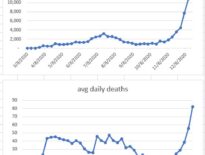Wednesday, November 11, 2020

After staying quite low through much of September and October, COVID-19 case numbers are rising again in LA County, as are hospitalizations for COVID. The LA County Department of Public Health warned last weekend that “transmission of COVID-19 is widespread and increasing in L.A County”. And if you think that’s bad, what’s happening in much of the rest of the country is worse. Regions across the South and the Midwest that didn’t have widespread COVID transmission this spring are seeing exponential growth in their case numbers. New daily cases in the US are at record levels, even higher than the bad-old-days in April when New York hospitals were inundated. Some hospitals, especially in less-populated areas, are approaching their capacity. So COVID-19 infections and hospitalizations are rising. The increase is fastest in regions that were previously spared but is happening here in LA also. Europe is experiencing a similar widespread increase in case numbers.
Why the dramatic increase now? Dr. Michael Osterholm, an epidemiologist and director of the Center for Infectious Disease Research and Policy at the University of Minnesota, blames the worsening numbers on pandemic fatigue. He posits that many people who previously were meticulous about physical distancing and masking are increasingly tired of adhering to the restrictions after 8 months. People are beginning to gather with family and friends who are not in their households, and these gatherings are fueling COVID transmission.
We are all tired of the pandemic. Grandparents miss their grandchildren. Kids miss their friends. Teachers miss their students. We want to go over to a friend’s house for pizza and a movie. We want to hug a loved-one. We want to pat a colleague’s shoulder. Physical distancing has taken a lot out of us. We want to believe that we’re close to the end of the pandemic, but the numbers tell us otherwise. We’re not at the beginning of the end of the pandemic; we’re at the beginning of the middle. Some tough months are still ahead.
So as hard as it’s been, there’s nothing to do but to return to what we know prevents COVID transmission. Avoid crowds. Avoid physical proximity (6 feet) to people not in your household. When in public places, wear a mask that covers your nose and mouth. The LA County Dept of Public Health reminds us that “Public celebrations and protests where people are close to each other, unable to remain six feet apart, cheering and shouting, especially without face coverings, are places where it is very easy and very likely for COVID-19 to spread.”
There are ways we can make it easier to live with these restrictions. Gather outdoors with those you miss and stay 6 feet away from them. As I wrote last time, stop worrying about contaminated surfaces, since it’s increasingly clear that COVID is transmitted by inhaling respiratory particles, not by touching surfaces. Don’t bother wiping down packages, doorknobs and counters. It won’t protect you from COVID and it will expend energy that should be conserved for the effective measures above.
So while we’re not yet at the end, the end is in sight. There are multiple companies working on promising vaccine candidates. By the first quarter of 2021 many of them will have completed trials showing that they are safe and effective. Pfizer’s vaccine has had some very encouraging early data, suggesting that their vaccine protected 90% of patients from COVID-19 infection. After we find out in early 2021 which vaccines are safe and effective, the monumental logistical challenge of manufacturing and distributing tens of millions of doses of vaccine will commence. This is likely to take months, and many questions and technical hurdles remain. Some of the vaccine candidates will need to be transported and stored in ultra-cold freezers which many medical facilities lack. The priority groups that should be first to receive the vaccines have not yet been determined. But despite these challenges, it’s reasonable to believe that enough people will have been vaccinated by the middle of next year to greatly slow the spread of the pandemic.
That could mean a return to the classroom for students in Fall 2021, and a return to movie theaters, restaurants, and friends’ homes for the rest of us. In the meantime, I wish you a Thanksgiving that is joyous and full of love and gratitude, but I pray you wait until 2021 for a Thanksgiving that is crowded with people who don’t live with you. So be of good cheer, for the worst is yet to come. But after that, it’ll get better.
Learn more:
Public Health Cautions Residents to Avoid Crowds with COVID-19 Spread Increasing in L.A. County (LA County Dept of Public Health, 11/7/2020)
LA County Daily COVID-19 Data (LA County Dept of Public Health)
U.S. Posts Fourth Straight Record as Daily New Coronavirus Cases Top 127,000 (Wall Street Journal)
Record Covid-19 Hospitalizations Strain System Again (Wall Street Journal)
The Osterholm Update podcast (Center for Infectious Disease Research and Policy)
Contagion and Contrition (my post reviewing how COVID-19 is transmitted)
Pfizer’s Covid-19 Vaccine Proves 90% Effective in Latest Trials (Wall Street Journal)

